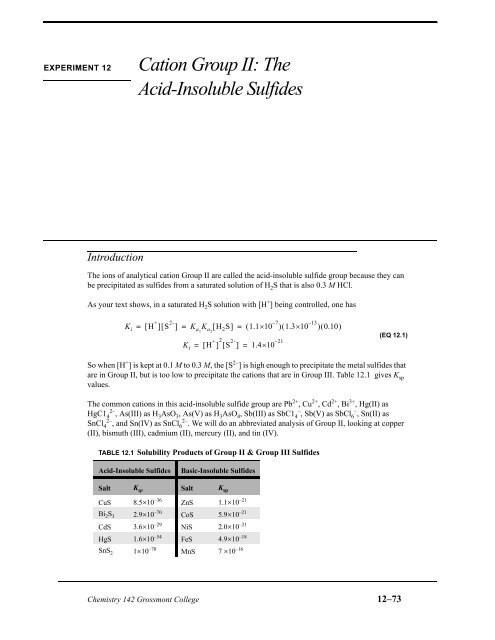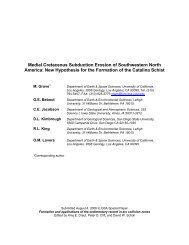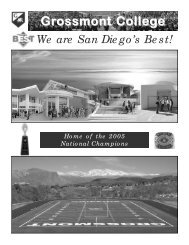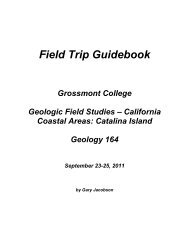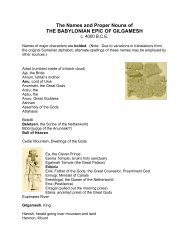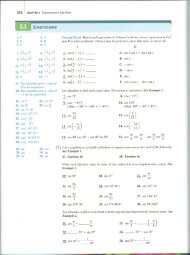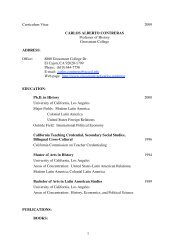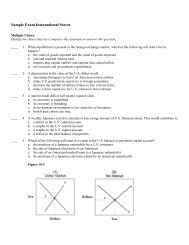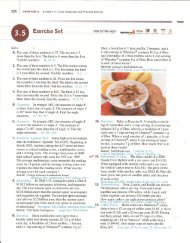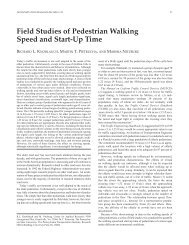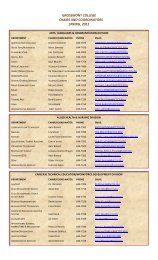Lab #12 Group II The Acid-Insoluble Sulfides - Grossmont College
Lab #12 Group II The Acid-Insoluble Sulfides - Grossmont College
Lab #12 Group II The Acid-Insoluble Sulfides - Grossmont College
Create successful ePaper yourself
Turn your PDF publications into a flip-book with our unique Google optimized e-Paper software.
EXPERIMENT 12Cation <strong>Group</strong> <strong>II</strong>: <strong>The</strong><strong>Acid</strong>-<strong>Insoluble</strong> <strong>Sulfides</strong>Introduction<strong>The</strong> ions of analytical cation <strong>Group</strong> <strong>II</strong> are called the acid-insoluble sulfide group because they canbe precipitated as sulfides from a saturated solution of H 2 S that is also 0.3 M HCl.As your text shows, in a saturated H 2 S solution with [H + ] being controlled, one hasK i [ H + ][ S 2-–7–13= ] = K a1K a2[ H 2 S] = ( 1.1×10)( 1.3×10)( 0.10)K i = [ H + ] 2 [ S 2- ] = 1.4×10–21(EQ 12.1)So when [H + ] is kept at 0.1 M to 0.3 M, the [S 2– ] is high enough to precipitate the metal sulfides thatare in <strong>Group</strong> <strong>II</strong>, but is too low to precipitate the cations that are in <strong>Group</strong> <strong>II</strong>I. Table 12.1 gives K spvalues.<strong>The</strong> common cations in this acid-insoluble sulfide group are Pb 2+ , Cu 2+ , Cd 2+ , Bi 3+ , Hg(<strong>II</strong>) asHgC1 4 2– , As(<strong>II</strong>I) as H 3 AsO 3 , As(V) as H 3 AsO 4 , Sb(<strong>II</strong>I) as SbC1 4 – , Sb(V) as SbCl 6 – , Sn(<strong>II</strong>) asSnCl 4 2– , and Sn(IV) as SnCl 6 2– . We will do an abbreviated analysis of <strong>Group</strong> <strong>II</strong>, looking at copper(<strong>II</strong>), bismuth (<strong>II</strong>I), cadmium (<strong>II</strong>), mercury (<strong>II</strong>), and tin (IV).TABLE 12.1 Solubility Products of <strong>Group</strong> <strong>II</strong> & <strong>Group</strong> <strong>II</strong>I <strong>Sulfides</strong><strong>Acid</strong>-<strong>Insoluble</strong> <strong>Sulfides</strong>Basic-<strong>Insoluble</strong> <strong>Sulfides</strong>Salt K sp Salt K spCuS 8.5×10 –36 ZnS 1.1×10 –21Bi 2 S 3 2.9×10 –70 CoS 5.9×10 –21CdS 3.6×10 –29 NiS 2.0×10 –21HgS 1.6×10 –54 FeS 4.9×10 –18SnS 2 1×10 –70 MnS 7 ×10 –16Chemistry 142 <strong>Grossmont</strong> <strong>College</strong> 12–73
Introduction<strong>The</strong> net reaction is the sum of these two orCuS (s) → Cu 2+ + S 2– (EQ 12.9)3S 2– + 8H + + 2NO 3– → 3S (s) + 2NO + 4H 2 O (EQ 12.10)3CuS (s) + 8H + + 2NO 3 → 3Cu 2+ + 3S (s) + 2NO + 4H 2 0 (EQ 12.11)Similar reactions occur for CdS and Bi 2 S 3 .Separation and Identification of Bismuth.<strong>The</strong> basis of the separation of Bi 3+ from Cu 2+ and Cd 2+ is the formation of insoluble Bi(OH) 3 inexcess NH 3 . Copper and cadmium form NH 3 complexes.Bi 3+ + 3NH 3 + 3H 2 O → Bi(OH) 3(s) + 3NH 4+Cu 2+ + 4NH 3 → Cu(NH 3 ) 4+Cd 2+ + 4NH 3 → Cd(NH 3 ) 4+(EQ 12.12)(EQ 12.13)(EQ 12.14)Identification of bismuth is achieved by addition of stannite solution which reduces the Bi(OH) 3 toblack metallic bismuth.2Bi(OH) 3(s) + 3Sn(OH) 3–+ 3OH – → 2Bi (s) + 3Sn(OH) 6–(EQ 12.15)NOTE: Stannite solution is a strong reducing agent that reacts with O 2 in theair. It must therefore be made just prior to use by treating a solution of SnC1 2 inHCl with NaOH. <strong>The</strong> net reaction is:SnCl 4 2– + 3OH – → Sn(OH) 3 – + 4Cl – (EQ 12.16)Identification of Copper. <strong>The</strong> intense blue color of Cu(NH 3 ) 4 2+ is a confirmation of copper.Identification of Cadmium. Cadmium is identified by precipitation of cadmium with H 2 S to formyellow CdS.Cd(NH 3 ) 4 2+ + H 2 S + 2OH – → CdS (s) + 4NH 3 + 2H 2 O (EQ 12.17)However, if the copper ions are present, they precipitate as CuS which is black and prevent the yellowCdS from being seen. Thus, copper must be removed before running the final cadmium test.This is done by addition of sodium dithionite, Na 2 S 2 O 4 , which reduces the copper (<strong>II</strong>) to metalliccopper but does not react with the cadmium in solution.Cu(NH 3 ) 4 2+ + S 2 O 4 2– + 2H 2 O → Cu (s) + 2SO 3 2– + 4NH 4+(EQ 12.18)Analysis of <strong>Group</strong> <strong>II</strong> BRepreciptiation of the Metal <strong>Sulfides</strong>. <strong>Acid</strong>ification of the basic solution of the sulfide complexescauses the metal sulfides to reprecipitate.Chemistry 142 <strong>Grossmont</strong> <strong>College</strong> 12–75
Cation <strong>Group</strong> <strong>II</strong>: <strong>The</strong> <strong>Acid</strong>-<strong>Insoluble</strong> <strong>Sulfides</strong>SnS 32–+ 2H + → SnS 2(s) + H 2 S (EQ 12.19)HgS 2 2– + 2H + → HgS (s) + H 2 S (EQ 12.20)Separation of Mercury From Tin. SnS 2 is soluble in concentrated HCl while HgS is not.SnS 2(s) + 4H + + 6Cl – → SnCl 6 2– + 2H 2 S (EQ 12.21)Identification of Tin. <strong>The</strong> tin (IV) is first reduced to the tin (<strong>II</strong>) state using metallic Mg in HClsolution.SnCl 62–+ Mg (s) → SnC1 42–+ Mg 2+ + 2Cl – (EQ 12.22)Addition of HgC1 2 in HCl solution to tin (<strong>II</strong>) results in a reduction of the mercury (<strong>II</strong>) to elementalHg (black) and insoluble Hg 2 Cl 2 (white) for an observed grey precipitate.2SnCl 4 2– + 3HgC1 42–→ Hg 2 Cl 2(s) + 2SnC1 6 2– + Hg (s) + 6Cl – (EQ 12.23)Identification of Mercury. HgS is one of the most insoluble inorganic compounds and requiresaddition of HCl + NaOCl which oxidizes the sulfide ion to sulfur and complexes the mercury (<strong>II</strong>)ion.HgS(s) + 2H + + 3C1 – + ClO – → HgCl 4 2– + S (s) + H 2 O (EQ 12.24)This solution must be heated for several minutes to destroy any excess hypochlorite ions, i.e.,ClO – + Cl – + 2H + → H 2 O + Cl 2 (EQ 12.25)Mercury is confirmed by adding SnC1 2 in HCl solution which reduces the Hg(<strong>II</strong>) to Hg and Hg 2 Cl 2as in the tin test above, producing a grey precipitate.3HgCl 4 2– + 2SnCl 42–→ Hg (s) + Hg 2 Cl 2(s) + 2SnCl 6 2– + 6Cl – (EQ 12.26)ProcedureTest a known solution simultaneously with your unknown. Do Steps 2, 3, 4, 8 and 9 on hotplate in the hood. <strong>The</strong> flow chart is Figure 12.1 on page 78.STEP 1: pH Adjustment. To 10 drops of solution to be analyzed add 6M NH 3 until just basic tolitmus (count the drops of NH 3 added). Add sufficient H 2 O to make 1 mL of solution; then addexactly 2 drops 6 M HCI. (This results in a pH of about 0.5.)STEP 2: Precipitation with H 2 S. Add 8 - 10 drops of thioacetamide (TA) solution, stir, and heatin a boiling water bath for 5 minutes. Stir several times while heating. Add 6-8 drops TA; heatanother 5 minutes. Cfg. (If the resulting solution is not clear, add 2 drops 1 M NH 4 Cl and heat for 3- 5 min. Cfg.) Treat the ppt (P3) as in step 3. Discard the supernatant.STEP 3: Separation of Subgroups. Wash ppt P3 with 10 drops H 2 O. Cfg. Discard the washings.To the ppt add 5 drops 6 M NaOH and 3 drops 2 M NaHS. Heat for 3-5 min, stirring occasionally.Cfg. Decant the solution (S4) from the ppt (P4). Repeat the extraction with NaOH and NaHS on theppt and combine the two extraction solutions (S4). Treat P4 as in Step 4. Treat S4 as in Step 8.12–76 Chemistry 142 <strong>Grossmont</strong> <strong>College</strong>
ProcedureSTEP 4: Dissolving Cu Subgroups (CuS, Bi 2 S 3 , CdS). Wash ppt P4 with 10 drops H 2 O. Discardthe washings. To ppt P4 add 5 drops 6 M HNO 3 and 5 drops H 2 O. Heat for 5 minutes to dissolve theppt. Cfg and discard any sulfur formed. (If considerable black ppt remains, treat it with a secondHNO 3 + H 2 O portion and combine both solutions.) Treat the solution (S5) as in Step 5.STEP 5: Precipitation of Bismuth. Cu Test: To solution S5 add 15 M NH 3 until it is distinctlybasic plus 1 drop. <strong>The</strong> development of a deep blue solution of Cu(NH 3 ) 4 2+ confirms copper. Cfg.Formation of a white gelatinous ppt (P5) indicates Bi(OH) 3 . Test P5 as in Step 6. Test the solution(S6) as in Step 7.STEP 6: Bismuth Test. Make a fresh solution of sodium stannite, NaSn(OH) 3 , by putting 3 dropsof 0.1 M SnCl 2 in a test tube and adding 6 M NaOH dropwise until the white ppt that initially formsredissolves. Add this solution to ppt P5. Formation of black elemental Bi confirms bismuth.STEP 7: Cadmium Test. If Cu(NH 3 ) 4 2+ is present in S6 (blue solution) add a small amount ofsolid Na 2 S 2 O 4 (sodium dithionite) about the size of half a pea. Stir well and heat for 3 - 5 min. <strong>The</strong>solution should become colorless and copper metal should precipitate. Cfg while warm and decantthe colorless solution (S7) into another test tube. (If the solution is not colorless or if copper metalhas not precipitated, treat again with Na 2 S 2 O 4 ). To the colorless solution S7 (or colorless S6 if Cuwas absent), add 5 drops thioacetamide and heat 3 - 5 min. Formation of a yellow ppt of CdS confirmscadmium.STEP 8: Precipitation of Hg Subgroup (HgS 2 2– , SnS 3 2– ). To S4 from Step 3, add 6 M HCl withstirring until just acidic to litmus. Heat for 3 - 5 min. Cfg and discard the liquid. Treat the ppt (P6)as in step 9. (If you obtain only small amounts of a nearly white ppt, you have only elemental sulfur.)STEP 9: Separation of HgS from SnS 2 . To ppt P6 add 1 mL 6 M HCl, stir and heat for 3 min.Cfg. Separate the solution (S8) from the ppt (P7). Treat the remaining ppt P7 with another 10 dropsHCl, heat, Cfg, and combine the solutions. Test P7 as in Step 11 and S8 as in Step 10.STEP 10: Test for Tin. To solution S8 add a 1 cm piece of Mg ribbon and heat to reduce theSnCl 62–to Sn 2+ . Cfg to remove any solid formed. To the clear solution add 5 drops of 0.1 M HgCl 2 .Formation of a silky grey-white ppt of Hg 2 Cl 2 + Hg confirms tin.STEP 11: Dissolving HgS. To ppt P7 add 6 drops 5% NaClO and 2 drops 6 M HCl. Stir to dissolvethe black HgS. Heat 3 - 5 min to decompose any remaining NaClO. Cfg and decant the clear solutioninto a clean test tube. To the clear solution add 3 - 4 drops 0.1 M SnCl 2 . Formation of a silkygrey-white ppt of Hg 2 Cl 2 + Hg confirms mercury.Chemistry 142 <strong>Grossmont</strong> <strong>College</strong> 12–77
Cation <strong>Group</strong> <strong>II</strong>: <strong>The</strong> <strong>Acid</strong>-<strong>Insoluble</strong> <strong>Sulfides</strong>FIGURE 12.1 Analytical <strong>Group</strong> <strong>II</strong> <strong>The</strong> H 2 S <strong>Acid</strong> <strong>Group</strong>Cu 2+ , Bi 3+ , Cd 2+ , Hg 2+ , Sn 4+H 2 S, 0.30 M HClCuS, Bi 2 S 3 , CdS, HgS SnS 2black, black, yellow, black, yellow-brownNaOH, NaHSCuS, Bi 2 S 3 , CdSHgS 2 2– , SnS 32–HNO 3HCl, just acidicSCu 2+ , Bi 3+ , Cd 2+HgS, SnS 2NH 3HClBi(OH) 3Cu(NH 3 ) 4 2+ ,Cd(NH 3 ) 42+HgSSnCl 62–NaClO, HClMgNaSn(OH) 3NaS 2 O 4BiblackCublackSHgCl 42–Sn 2+Cd(NH 3 ) 42+SnCl 2HgCl 2CdS, yellowH 2 SHg + Hg 2 Cl 2black + whiteSnCl 62–Hg + Hg 2 Cl 2black + whiteSnCl 62–Questions1. Write net-ionic equations for & the reactions occurring for each cation in the group.a. copperb. bismuthc. cadmiumd. mercurye. tin12–78 Chemistry 142 <strong>Grossmont</strong> <strong>College</strong>
Questions2. Give the formula for a reagent which will:a. dissolve SnS 2 but not HgSb. dissolve Cu(OH) 2 but not Bi(OH) 3c. form a precipitate with Cu 2+ but not with Cd 2+d. form a precipitate with Bi 3+ but not with Cd 2+e. form a precipitate with HgCl 2 but not with SnCl 23. Give the formula of a site reagent (or combination of reagents if a single reagent is insufficient)which would enable you to distinguish between the following pairs of compounds contained inseparate test tubes. Tell what would happen in each case to let you make the distinction.a. Cu(OH) 2 and Bi(OH) 3 (solids)b. Hg 2+ and Cd 2+ (solutions)c. Ag + and Cu 2+ (solutions)4. CuS (K sp = 8.7×10 –36 ) is the least soluble of the <strong>Group</strong> <strong>II</strong> sulfides while PbS (K sp = 8.4×10 –28 ) ismuch more soluble. Consider a solution saturated in H 2 S (0.l0 M) and 0.3 M HCl (the conditionsfor pptn of <strong>Group</strong> <strong>II</strong> cations).a. Calculate the [S 2– ] present.b. Calculate the concentrations of Cu 2+ and Pb 2+ ions that remain in solution (unprecipitated)at these conditions.Chemistry 142 <strong>Grossmont</strong> <strong>College</strong> 12–79
Cation <strong>Group</strong> <strong>II</strong>: <strong>The</strong> <strong>Acid</strong>-<strong>Insoluble</strong> <strong>Sulfides</strong>12–80 Chemistry 142 <strong>Grossmont</strong> <strong>College</strong>


